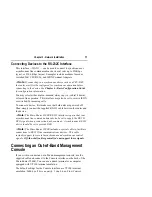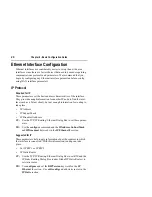
Chapter 3 - Network Installation
11
Connecting Devices to the RS-232C Interface
This interface -- WAN 1 -- can be used to connect to synchronous or
asynchronous line communications devices at rates up to 256Kbps
(sync), or 230.4 Kbps (async). Examples include modems, leased or
switched 56K CSU/DSUs, and ISDN Terminal Adapters.
L
Note:
If connecting to a synchronous device such as a CSU/DSU,
the router must first be configured for synchronous operation before
connecting to the device. See Chapter 6 - Basic Configuration Guide
for configuration information.
You may select either dial-on-demand, always up (i.e., redial if down),
or leased line operation. This interface may also be set to receive ISDN
or switched-56 incoming calls.
To connect a device, first make sure that both units are powered off.
Then, simply connect the supplied RS-232 cable between the router and
the device.
v
Note:
The MicroRouter 2200R RS-232 interfaces require that your
asynchronous line communications device be set to supply the RS-232
DCD signal when a connection has been made. A synchronous RS-232
device should be set to provide DSR.
v
Note:
The MicroRouter 2200R includes a special cable to facilitate
connections to RS-232 line communications devices. This cable
includes support for several asynchronous and synchronous control
signals. Off-the-shelf cables generally do not support these signals.
Connecting an Out-of-Band Management
Console
If you wish to connect an out-of-band management console, use the
supplied cable and connect to the Console interface on the back of the
MicroRouter 2200R. You can use a dumb terminal or a computer
equipped with VT100 terminal emulation.
The default settings for the Console interface are VT100 terminal
emulation, 9600 bps, 8 bits, no parity, 1 stop bit, no Flow Control.
















































